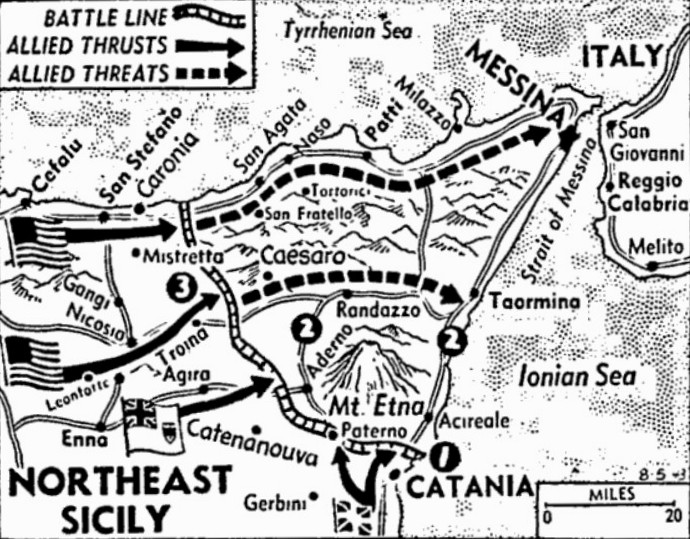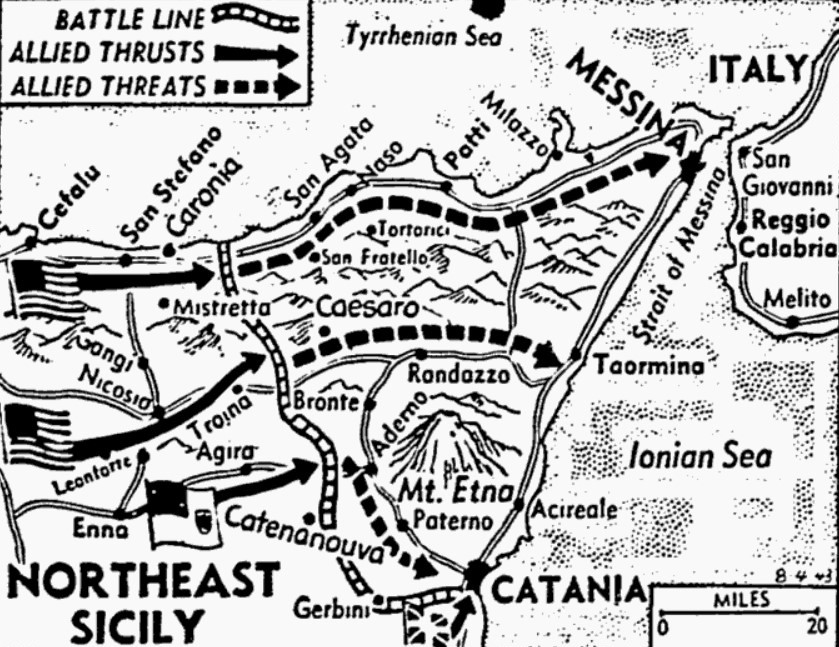The Pittsburgh Press (August 5, 1943)
Drive threatens to trap elite German forces chased from eastern Sicilian port
By Virgil Pinkley, United Press staff writer

Victory at Catania was scored by the Allies in the capture of the heavily-defended Sicilian city (1). Paternò to the west was also occupied. The two roads for escape of the Axis troops in the Catania area (2) were blocked, the western road by the capture of Paternò and the eastern highway by naval shelling. In the north, U.S. troops (3) drove toward Randazzo.
Allied HQ, North Africa –
The Allies crumpled the lower end of the Axis line across southeast Sicily today by capturing Catania and the nearby transport junctions of Paternò and Gerbini, and to the north beat back the enemy defenses with a shattering land, sea and air bombardment.
The British 8th Army swept across the Catania plain under cover of the intense artillery fire and seized the ancient city of Catania to blast out the southeastern anchor of the wilting Axis line.
Other forces swarmed around to the northwest and took Paternò, core of a highway network keying the communications around the western slopes of Mt. Etna. The thrust threatened to trap the elite German troops who were thrown out of Catanias.
The 8th Army also seized Gerbini, 12 miles west of Catania and center of a major cluster of Axis airfields.
With the liquidation of the Sicilian campaign described as “only a matter of time” after the British 8th Army entered Catania, the Americans and Canadians pounded forward through stiffened resistance and heavy minefields on the central and north coast fronts in their drive to push the Axis back toward heavily-bombed Messina, last port of exit from the island.
Ned Russell, United Press correspondent, said in a dispatch from Catania that the hungry inhabitants of the city gave the British troops a tumultuous welcome.
The fall of Catania was followed quickly by the seizure of Paternò, which is an important road junction about 12 miles to the northwest in a web formed by mountainous roads and a railroad looping around the west side of Mt. Etna.
The Allied gain cut one of the main roads by which the Germans and Italians could escape from the Catania trap and put British forces near or astride the only railroad on the western slopes of Mt. Etna. Allied warships and bombers hammered the other escape road on the east side of the peak.
The fall of Paternò and Catania appeared to doom the town of Misterbianco, midway between the two bigger towns and on the main escape road out of Catania (Misterbianco means Mr. White).
The Americans pushing from Troina toward Randazzo and the Canadians hammering toward Adrano, which guards the only road by which the enemy can circle west of Mt. Etna, were reported fighting in the most difficult terrain. The enemy had laid heavy minefields in their paths and moved up mobile guns, as well as elements of the 15th Panzer Division.
The Allied forces are compelled to attack uphill at almost every point against hidden gun emplacements, often dug deeply into the rocks.
The doom of Catania had been sealed by the capture of Centuripe which gave the Allies high ground from which to blast ahead.
Despite a desperate enemy rearguard action, the British broke through to Catania from the south while the 78th Division attacked from the northwest and Canadians smashed into the enemy western flank. Many prisoners were taken and many others appeared to be trapped as the Allied offensive neared the road and railroad bottleneck at Adrano, only eight miles north of Paternò.
The British 8th Army under Gen. Sir Bernard L. Montgomery crashed into Sicily’s second city at 8:30 a.m., after the sun-browned Northumbrians of the 50th Division (who crashed the Mareth Line in Tunisia), the 51st Highlanders, and the veterans of the 78th Division (who fought at Dunkirk) had slugged their way through the strongest enemy defenses on the island.
In London, observers suggested that all organized resistance in Sicily might be overwhelmed in three days. The German radio said Catania had been evacuated in “the most successful maneuvers” yet carried out in Sicily “to mislead the enemy.” The Nazi broadcast said the Germans had retired to a much stronger line behind Catania.
The best Axis troops, including remnants of the reformed 6th Army which was liquidated at Stalingrad, the armored Hermann Göring Division, the 15th Panzer Division, the 29th Motorized Division and units of paratroops who were sworn to fight to the death, vainly attempted to check the Allied advance.
Allied pilots returning from Catania said military targets there were pitted with bombs, especially in the railroad yards south of the town where tracks and sheds were directly hit. The Dacino di Ponente customs house was badly damaged and part of the central station destroyed. The northern part of the town was wrecked by fire, all airdromes were hard hit and the Fascist Party headquarters damaged, but much of the residential section was only slightly damaged.
The port of Catania was not damaged as badly as other ports in Sicily such a Palermo and Trapani, although several sunken ships were in the harbor.
In the air, U.S. Flying Fortresses rocked Naples, Italy’s biggest port, with its fourth blockbuster raid in four days, reminding Italians that they will see only destruction and death until they capitulate.
Allied fighters and fighter-bombers destroyed 60 enemy trucks and other vehicles in behind-the-lines attacks yesterday to facilitate the ground advance. Eighty other vehicles were damaged.
The submarine base and docks were the main targets at Naples and the communiqué said they were “well covered by bombs.” One merchant ship was left afire. Eleven intercepting aircraft were shot down as the Fortresses ran into the heaviest aerial opposition in some time.
British Wellington bombers also attacked the Italian mainland Tuesday night, hitting Paolo and Catanzaro on the east coast of the toe of the boot, and Marauder medium bombers followed through with daylight raids on the same targets yesterday. The two towns are situated on the railway running from Naples down to Reggio Calabria, opposite Sicily.
U.S. motor torpedo boats were revealed to have joined small British craft in sweeping the Strait of Messina of Axis shipping.
The Northwest African Air Forces, now largely operating from Sicilian bases, maintained heavy shuttle attacks on enemy supply dumps, road communications and motor transport throughout yesterday, leaving blazing supplies and trucks in their wake.
Other night bombers heavily attacked Messina and Battipaglia, another important junction on the Naples-Reggio Calabria railroad, last night.
Three Allied planes were lost in all operations in the 24 hours ended last midnight and further reports shows that six additional Allied planes were lost Tuesday.
Axis planes have put in a sudden reappearance, it was revealed, and have attacked Allied shipping in Palermo Harbor on the north coast of Sicily several times in the last five days. Minor damage was caused, the communiqué said, and U.S. warships drove off the raiders with anti-aircraft guns.
At least seven out of a formation of 30 Ju 88 dive bombers were shot down in a pre-dawn raid last night.


